By Donna Insco
Baby animals born on the farm are a rite of spring, and few things are more appealing than young goat kids cavorting in the fields. But the road to healthy newborns actually starts the fall before.
I start preparing for spring kids the first day of August by doing two things: I make my final decision on which female kids to keep as replacement does, and I remove the buck from all contact with the rest of the herd. Goats are seasonal breeders, and as the days begin to shorten in August, the decreased day length triggers hormonal changes in both males and females.
In early September, females begin cycling into estrus. Does will come into heat every 18-21 days and will continue to do so for several months or until they mate and become pregnant. Signs of estrus in females are excessive tail wagging, mounting other females or being mounted by them, and bleating loudly while staring in the direction of the buck pen. There is also a phenomenon known as “short cycling” when a doe shows signs of being in heat a mere 7 to 10 days after a previous heat cycle. Short cycling most often occurs with young does, but any age doe can experience it. If not bred, they will cease coming into heat in late January when lengthening daylight signals the close of estrus.
Male goats experience dramatic changes, also, as they prepare for breeding. This event can be likened to “the rut” experienced by members of the deer family. Like deer, a buck goat’s neck will swell, he will urinate on himself, develop a rank odor, and he will become very aggressive. He will attempt to breed any doe that he thinks is in heat, regardless of her age or condition. Keep in mind that goats can and will breed through a field fence, so to avoid accidental early breeding, it is best to put him into an area that doesn’t share a fence line with the females.
One of the keys to healthy spring kids is proper breeding weight for their mothers. Young standard breed does may be bred when they reach 75 pounds. (Small breeds, such as Nigerian Dwarfs should be at least around 70% of their adult weight.) But does will cycle into heat their first fall, even if they are far below this weight. Often, the youngest, smallest doeling in my herd will be the first to come into heat. Pregnancy before a doe is physically big enough is dangerous for her. A small, underweight doe may be unable to pass the kid through the pelvic canal, leading to the deaths of both the doe and her offspring. I feed my young replacement does a 14% protein ration, good quality hay, and pasture to make sure they reach breeding weight by November. It is also important to ensure older does get adequate food. Studies suggest that increasing the amount and protein content of feed just prior to breeding, called flushing, can increase a female’s chance of having twins. A couple of extra cups of grain in the feed pans prior to and during breeding season can really pay off in the spring.
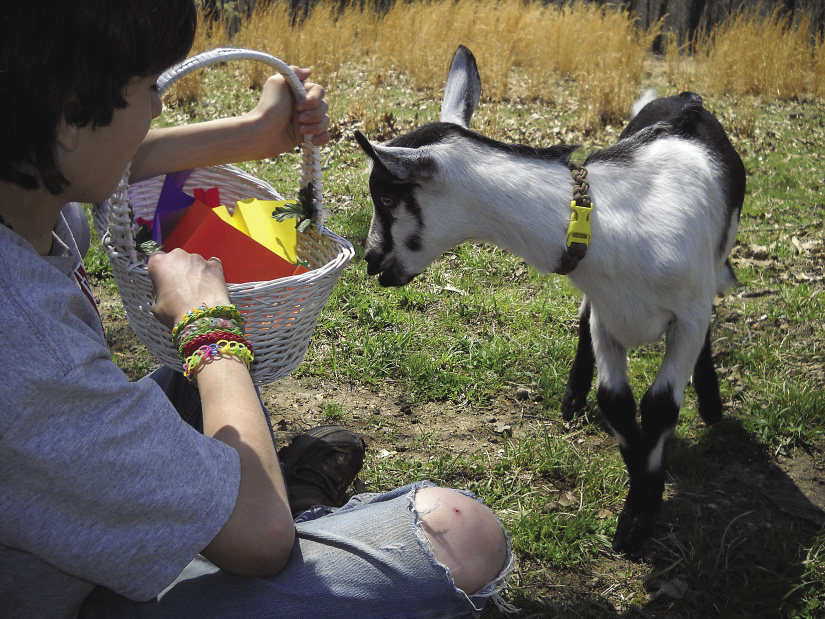
Winters can be cold in my area, so I prefer to have newborns in March. When I allowed breeding in September, my does often dropped kids in early February on the coldest night of the winter. One of my goat kids lost the tips of her ears to frostbite within minutes of birth during one cold winter. Since a goat’s gestation is 150 days, I now allow breeding to begin the first week of October. This gives me kids in March when it is generally warmer. I mark on a calendar each doe’s breeding date and her due date so there are no surprises in the spring.
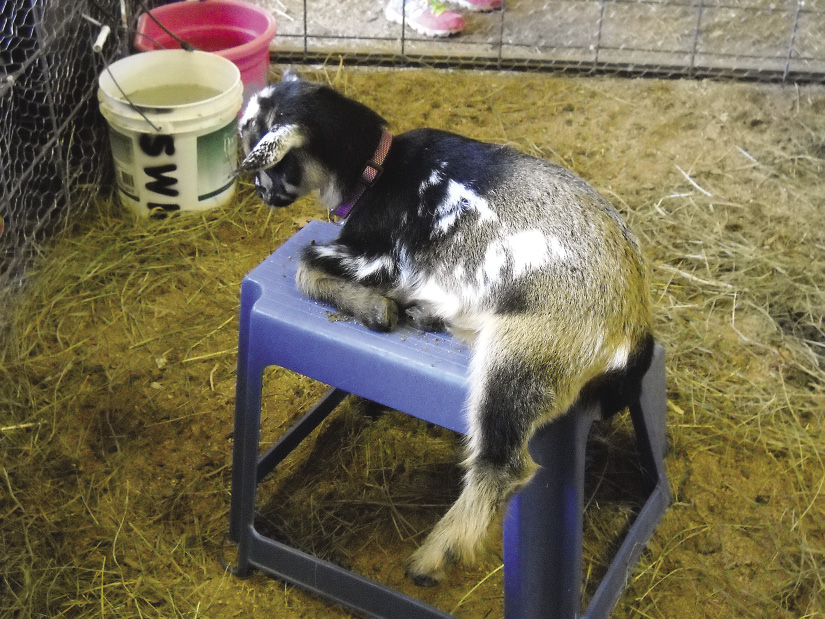
Preparation
It’s a good idea to prepare in advance for the kids’ arrival. Goats prefer to give birth in a sheltered location, especially if the weather is cold or damp. So if a barn is available, most of them will give birth indoors. I have a goat barn with a loafing area and two stalls reserved for newborns and their mothers and this gets a thorough cleaning a few weeks prior to the first due date.
Goats seldom need help during the actual birthing process, so few supplies are needed. My goat birthing kit contains:
• Sharp scissors — to cut the umbilical cord
• 9% Iodine — to disinfect the scissors and the cut cord
• A cap from a pop bottle to use as an iodine cup
• Nitrile gloves
• Mineral oil — to lubricate gloved hands if you need to assist in a birth
• Paper towels — to help dry off kids
• A baby monitor
• A feeding tube and syringe
• Elastrator castration tool
• Electric dehorning iron
Many does will announce the onset of labor by bleating loudly. Others give birth quietly but communicate with their newborns by grunting gently. A baby monitor transmitting unit placed in the barn will let you know when labor commences or allow you to hear the soft bleating of baby goats. Be sure to pick a spot where the goats can’t reach the unit, because they will delight in tossing the unit to the ground and chewing the cord. I place my portable receiver in the kitchen on top of the refrigerator, turn it up loud, and leave it on starting a few days before the first doe is due to drop kids.
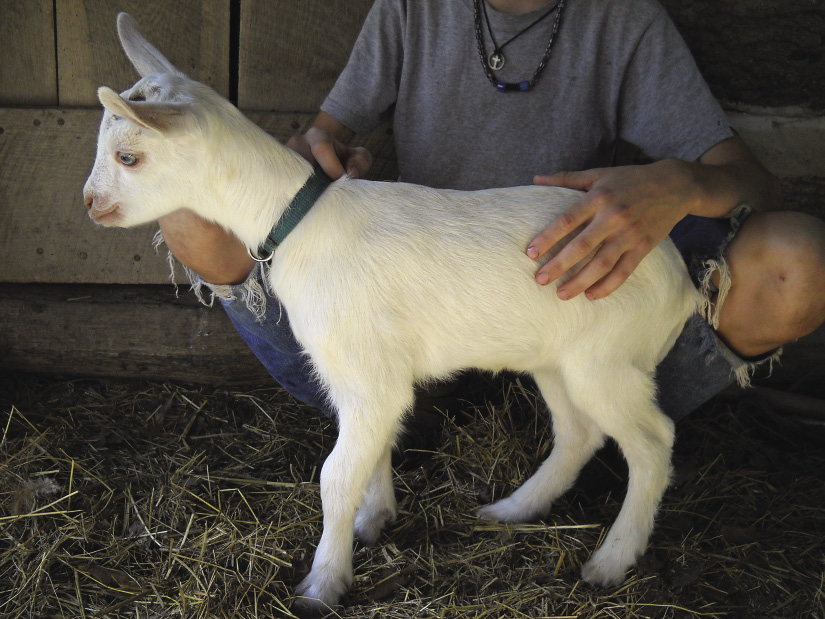
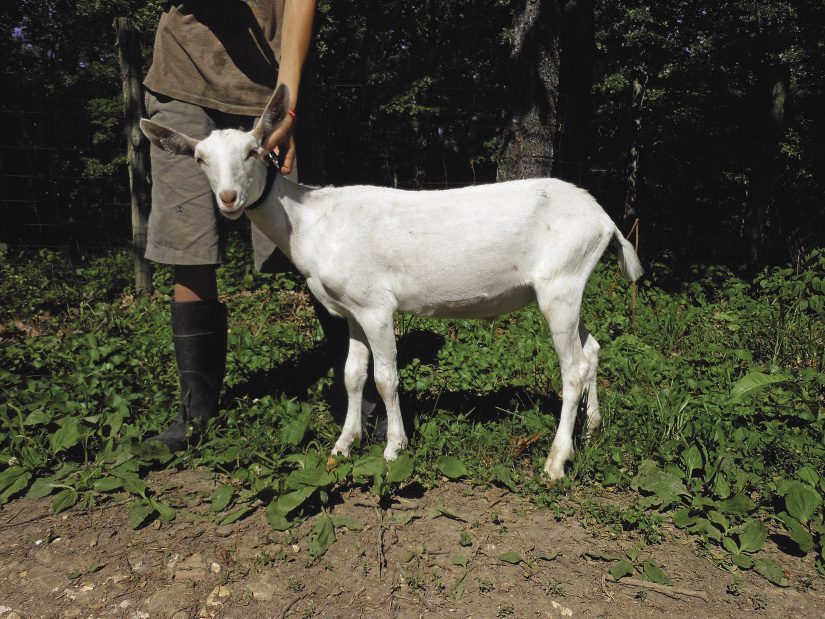
The big event
Don’t be surprised if you can’t predict the moment a doe will deliver. Some of my does seem to stay pregnant forever. They miss their due dates and lie around basking in the winter sun like walruses. Others will drop kids two or three days early. Several times I have checked on the does in the evening and confidently stated, “No doe will give birth tonight.” Then I have left the barn, returned 10 minutes later looking for some misplaced item, and managed to stumble over newborn twins lying just inside the door.
The fetuses are usually in the proper birth position by the time they have engaged the birth canal and are ready to leave the womb. Normally, their heads and necks are stretched out along the front legs so they are born front hooves first. A few days prior to labor the fetuses appear to drop lower in the abdomen. This often causes a noticeable hollow to develop in the doe’s flanks below the spine and directly in front of the hip bones. Also, the lower spine between the hip bones and the base of the tail appears more pronounced as the flesh along the top of the pelvic bone sinks downward. These changes signal that labor will begin within a few days.
Hard labor for goats is often short. A doe may become restless, standing up and lying down repeatedly. She may show a little bloody discharge or none at all. She may bellow loudly, or remain nearly silent. Sometimes the only clear sign a goat is in hard labor is the appearance of membranes like a small balloon containing fluid, two tiny hooves, and the tip of a nose. As long as she is making progress, don’t intervene. Usually within minutes, she has passed the kid’s head and forequarters. Often by this time a doe will stand and the rest of the kid will slip out quickly, hitting the ground with a thud and breaking the umbilical cord.
The new mother will usually turn immediately and begin licking the kid around the head and face. Healthy kids will already be sneezing fluid out of their nostrils, their heads bobbling on unsteady little necks. I help wipe the fluid off the kid’s face and nose with paper towels. If it’s not too cold, I let the doe clean the kid off as much as she chooses. This tasting and smelling of her kid is an intimate way females bond with their young and helps her recognize the kid’s scent. Does carrying twins will usually drop the second kid within a few minutes of the first one. After giving the mother time to lick and nuzzle the kids, I finish drying them with paper towels. I rub hard and fast to stimulate their circulation and fluff up their hair.
At this time their umbilical cords are trimmed and disinfected. Douse the scissor’s blades with iodine and cut the cord within ¼ inch of the kid’s stomach. Pour iodine into the cap of a pop bottle, and place the cap over the navel area. Holding the cap firmly to the kid’s stomach, pick him up and quickly turn him over on his side to allow the iodine to soak the entire navel area. The iodine stings and the kid will cry out, but in a moment he will be fine. Let the area air dry, and be careful not to get any iodine on the kid’s genitals. Discard any iodine left in the cap — don’t pour it back into the bottle or you may contaminate all of the unused iodine.
A goat will pass the placenta shortly after delivering her kids. Some does will eat the placenta, but many won’t. After 30 minutes, I remove it from the barn and bury it. The bedding from the immediate area is also forked up and removed to the compost pile, and then replaced with fresh bedding.
Healthy youngsters will attempt to stand and nurse very soon after birth. After crashing into the wall and sprawling head first into the bedding several times, most youngsters manage to attain an uneasy alliance with gravity. Once they gain their footing, they search for something to suck on, not exactly sure what they are looking for. They try out their mother’s knees, hocks, chest, or stomach before finally discovering the udder. Even then, it takes a while to find the correct spot. Some kids spend long minutes sucking where the teat joins the udder floor, or nibbling the middle of the teat like a child trying to eat a too-big ear of corn. Through all of this a good mother will stand patiently. Does don’t actually encourage their kids to nurse; they just make themselves available for strong kids to figure it out for themselves. I like to stay with them and witness the first feeding so I know the newborns are off to a good start.
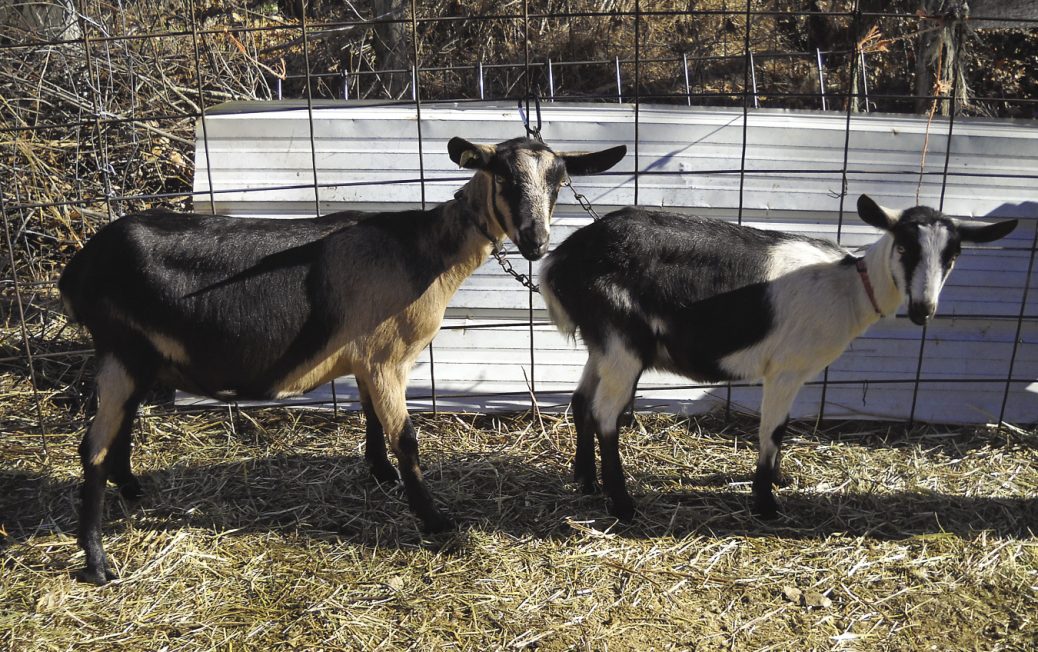
I like to separate new mothers and their young from the rest of the herd for at least 24 hours. That way the mother doesn’t feel the need to stand over her newborns protecting them from the herd, and she has plenty of time to eat in peace. It also lets first-fresheners (first time mothers) understand that yes indeed, those babies are hers. I put fresh bedding, a bucket of water, and hay into one of the stalls reserved for newborns. I then put the doe and her new kids into the stall.
I check the newborns periodically throughout the day to make sure all is well. For a few days after giving birth, a doe’s milk contains mostly colostrum. This nutrient and antibody-rich substance is critical for the survival of the kids. If I haven’t actually seen kids nurse, I make sure they have eaten something by checking the girth of their abdomens. Newborns lack the ability to eat very much at a time, so they may get only a few ounces of colostrum per feeding. But a kid that has received nourishment should have a tummy that appears rounder than when it was born. Kids should also appear warm and content. Twins usually snuggle together instinctively, but occasionally, I need to carry one out of the corner and place it next to its sibling.
Problems during delivery
Healthy goats of proper breeding weight and condition rarely have trouble giving birth. When they do, however, it is considered an emergency. A kid will not last long if the mother can’t clear it from the birth canal. But how long is too long to wait? If a doe is presenting any part of a kid, such as hooves, and has been straining for more than 15 minutes without making any progress, I consider intervention.
Put on nitrile gloves. If both front hooves are presenting, grasp both of them and pull gently when the doe is actively pushing. Once the kid starts to move along, let the doe do the rest. But sometimes the kid won’t budge, or the kid is not in the proper birth position.
Try to decide what the problem is. The kid may not be able to move down the birth canal if one front leg or the head is twisted backward. Sometimes the head is coming without the front legs. Invasive tactics may be called for in these instances. Lubricate a gloved hand with mineral oil and insert it into the doe’s vagina. Try to find the missing hoof or head and ease it forward. I have untangled a kid whose head was twisted backward by pulling on an ear until the head swung partway around, then sticking my thumb in its mouth and dragging it forward by the lower jaw.
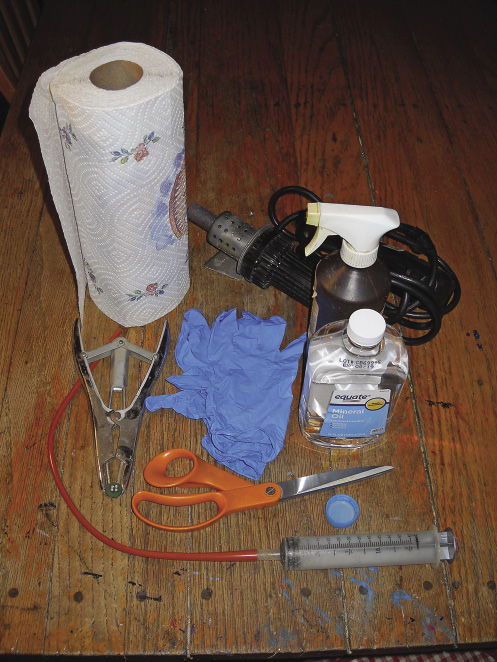
Make no mistake, invasive tactics hurt the doe and none of this is pretty. She will scream and kick. There will be slime and blood while you struggle to find something you can’t see, can’t identify, and can’t reach. You will be on your knees wallowing in whatever is on the barn floor desperately trying to gain leverage over a small fragile life that is threatening to extinguish itself in front of you. Sometimes there is not even a reward. Sometimes, it’s too late and all you manage to do is deliver a dead kid. Thankfully, those instances are few. In the twenty-plus years I have raised goats I have only lost five kids and one doe during birth. Before your does go into labor, decide what you are willing to do to assist. Just be aware that if the doe cannot deliver a kid, both she and the kid will die.
Problems with newborns
Most does instinctively make good mothers and their offspring thrive. Kids that nurse well during the first 24 hours of life and receive colostrum usually don’t have any problems. Sometimes, however, a kid fails to nurse. The warning signs include: any kid that appears lethargic or off by itself, one bleating for no apparent reason, or an overly chilled kid.
An overly chilled kid rapidly loses the sucking reflex and can die quickly from hypothermia. Hypothermic kids can occur in the first hours of life due to cold weather, or when a kid becomes separated from the doe and fails to nurse soon after birth. You might be able to revive a chilled kid with a feeding tube. One cold winter morning I found an eight-hour-old kid lying flat on her side in the corner of the stall. She was cold to the touch but I thought her eyelids fluttered when I picked her up. Shoving her under my jacket, I ran to the house and laid her on the hearth in front of the wood stove. I ran back out to get some colostrum from her mother.
There was no time for proper technique. Although I had never put a feeding tube down an animal’s throat, the dying kid had nothing to lose. I rolled the kid onto her sternum and laid her chin on my knee so her head was elevated and her neck was stretched in an approximation of the suckling position. “Eyeballing” the distance between her lips and where her first stomach should be, I slid that amount of tube down her throat. Next, I filled the syringe full of milk, attached it to the feeding tube, and began pushing the plunger to send milk down the tube. The kid still showed no signs of life, so I left her lying on the hearth and tried to hide my disappointment. Within 15 minutes, however, the kid I thought was dead had her head up, grunting for more. I kept her in the house in the mudroom for three nights. Each morning, I carried her out to the barn so her mother wouldn’t forget her and made sure she nursed.
Since then, I have managed to save three other “flat” kids with a feeding syringe. While this is a valuable part of my newborn kit, I never want to be especially good at this technique. Every time I need to use it I feel that I have made a mistake — either I let does have kids too early in the year, or I failed to make sure all kids nursed.
It is a good idea to milk a little excess colostrum 24 hours after delivery from the first doe that gives birth. It lasts for several months frozen in pop bottles and can be used for a kid whose mother dies or rejects it. Although rare, rejection of offspring does occur. Any doe that butts her own newborns away is likely rejecting one or both of them. Unless you provide supplemental milk to rejected kids, they will die. I don’t want a bottle baby, so I try to prevent this. A doe may change her mind if she is put in a stanchion and forced to let her kids nurse many times each day. This attitude adjustment will likely take a week or more and you will need to remain vigilant for weeks afterward. Even then, partially rejected kids seldom thrive and often appear stunted for months.
Day three
The third day of life is ideal for removing horns and castrating males. Both of these procedures involve stress to youngsters, but by day three, healthy goats are sturdy enough to recover quickly. The horn bud is small at this age and easily destroyed with an electric dehorner, so goats will never develop dangerous horns if done properly. But if delayed a few weeks, rapidly growing horns get large enough to start damaging a doe’s udder. For tips on disbudding, see my article “An alternative way to remove goat horns” in Self-Reliance Book Two.
Day three is also ideal to castrate young males. Kids are small, easy to handle, and the procedure can be done by one person. I use a tool called an elastrator that uses rubber bands because it is easy and bloodless. Stretch an elastic band over the retaining clips on the elastrator. Pick up a kid, turn him over on his back, and place him in your lap. Grasp the base of the scrotum with two fingers of one hand, making sure both testicles have descended. Then quickly slide the stretched rubber band over the scrotum and place it next to the kid’s abdomen. The band will cut off the blood flow to the testicles, causing them to atrophy and fall off in a few weeks. Most kids bleat a bit and kick a hind leg a few times, then lie down or run to their mother. The scrotum goes numb soon after and the kid forgets anything happened.
All of my newborns get collars on day three also. In just a few days kids are rambunctious and leaping about like grasshoppers. It’s much easier to reach out and grab a collar than a leg as they go speeding by.
Day seven and beyond
I allow kids to nurse all they want until they are a week old. By day seven the doe’s milk no longer contains colostrum and I start saving it for cheese making. I milk my does once a day in the morning. In the evening, I separate the does and kids and lock the kids in a stall. A little choice hay is put in the kids’ stall for a snack overnight.
The does receive their grain ration on the milking stand in the morning. Afterwards, the kids rejoin their mothers and the whole herd gets good quality hay. Youngsters become interested in hay by their third week of life, although milk remains their primary source of nutrients. One day per week the does aren’t milked, allowing their kids to take all of that day’s milk. When the pasture greens up, the herd is allowed to spend most of the day in the field. The does’ hay ration is cut once the grass is growing well, but the kids still get hay at night. My kids grow well and remain healthy on this regime. I seldom feed the kids grain until late summer after deciding which ones will become replacement does.
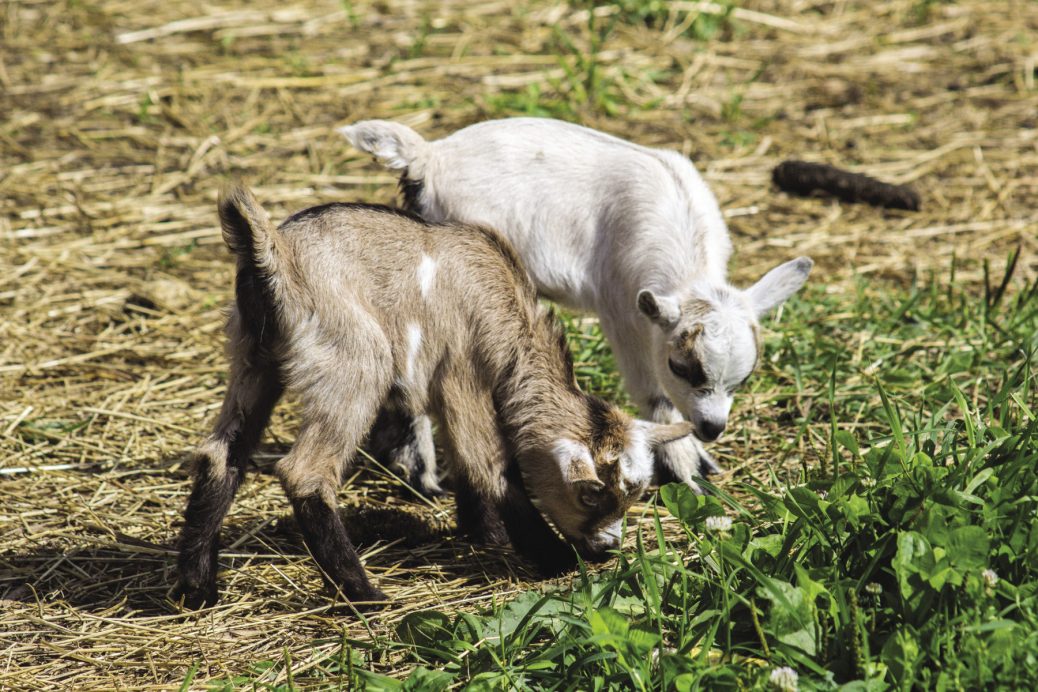
Young kids should always appear alert and curious. The most important things in their lives should be their mothers, food, and play. Suspect internal parasites or illness if a kid is disinterested in any of these things. Your veterinarian can make a diagnosis and suggest the correct treatment.
Young kids can also run into trouble in the environment. It’s a good idea to examine your buildings and pastures for obstacles that might cause youngsters harm. Make sure baling twine or barbed wire is secure so kids don’t become entangled. Young kids can slip through a small opening, such as the opening of a cattle panel, so make sure dogs or other predators can’t access the area. Kids are never alone by choice, so take a head count several times each day and investigate if any are missing. Likewise, if there is a commotion in the paddock, goats are running wildly across the field, or any youngster is crying continuously, it’s time to discover why.
Final thoughts
Always treat your goats very gently. They will come when called if they associate their keeper with kindness and good things to eat. They will forgive indignities like vaccinations and hoof trimming if the majority of their memories are pleasant. If they are never given a reason to fear, they will reward you with their trust and their best production.
Goats are hardy animals, but proper management decisions by their owner are crucial for the health of the herd. So remember the keys to healthy spring kids: Proper breeding weight for their mothers, adequate nourishment soon after birth, plenty of milk and quality forage, and an attentive herdswoman.

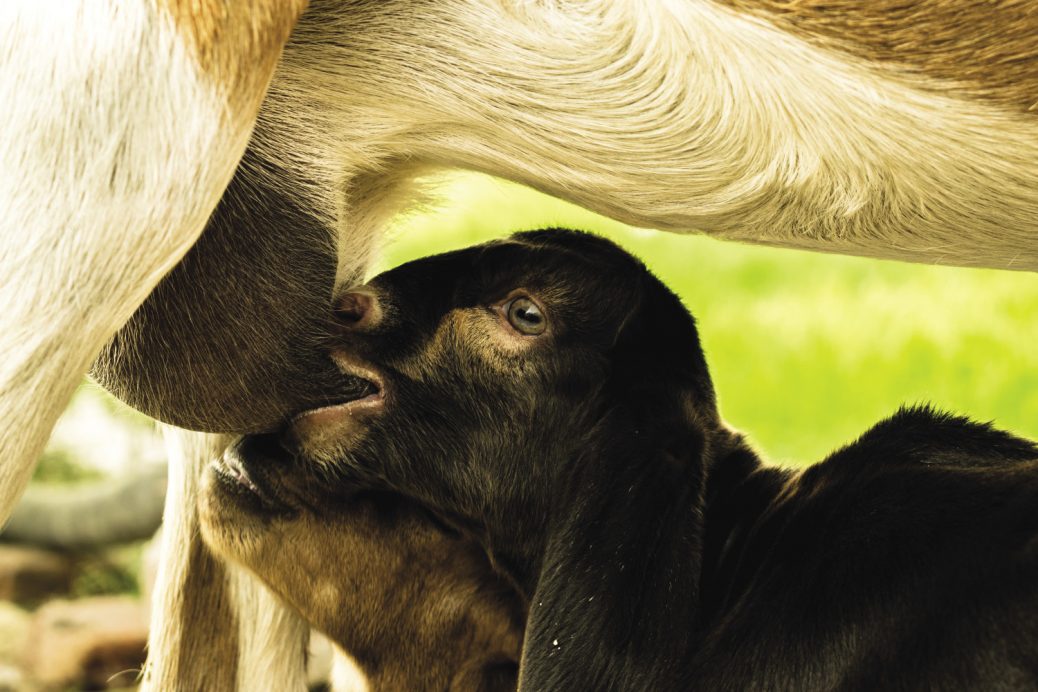
We’re first timers and have a fine young Alpine buckling.
Thanks for the easy (to understand) explanation of newborn preparedness.
Im new to the goat life. I now have my first set of babies!! They did both nurse off mom. I did keep them seperated the first 24hrs. But mom did leave babies in the stall.. Wandered out to eat.. I got worried she didnt go check on them ..so i cooped her back up with them for nursing. Is that normal for moms to leave them unattended for that long? Should i be concerned? Or bottle feeding? The babies seem allert and happy?
I love this article. It’s so easy to read and understand! This article helps me understand a lot that I was questioning before. Thank you for all the information. It helps me understand a lot!
Thankyou for explaining goat birthing in such understandable and easy reading text.
I too am new to goat breeding and have 4 does ready to give birth sired by a very happy and healthy Boer buck. He is now 11 months old.
Once again , thanks, and it is good to read your prose written from the heart ❤️.
Cheers and “Keep on Smiling “
I really enjoyed your article.? Two days ago, we had our first set of triplets! Rea, decided to leave us out of it until the last had already hit the ground. She was a couple weeks early for her. WELL first of the year here. We have a few more does to go.
Most helpful article I’ve ever found! I’ve done so much research and joined groups and have never been satisfied with the info. Thank you.
One of my does had her first a week ago, the other doe had 3 today. Do these goats need any kind of shots??
2nd question, if they are immediate brother and sister is this bad? What problems can this cause? 3. How young is very very young for a buckling to try to have sex w his mom? As u can see im new to all this goat stuff and would really love any feedback. Thanks in advance!
I prchased a male and female goat a ehile back. This am i go to the stall and theres a kid buckling (prob not right terminology),i was told they werent brother and ister but im not sure. Since its just the 3 of them My question is do i need to keep mom and kid seperated from the buck, atleast for a few nights? The mom and dad have been kept together since they were born (im assuming) and don’t want dad becoming depressed. Yet i am nervous he wil hurt the kid or the mom will reject him since she has her best buddy there in the shed.
I have a two week old boar buck and put a band on him ,but then read that two weeks was to young so I removed it ,it was on for about 4 hours have I done any damage to him .
We rescued two does both have utters that hang low. After the birthed a kid it is hard for baby to find mothers teet. Any tips? Thank you Scott
My daughter has had several years of kids and birthing. One thing she does that bothers me but not her is letting Momma out to graze for 2 or so hours and brings the kids inside the house to stay warm & play around. They have hardwood floors and they love running up and down the hall from the prompts of my grandsons. Is this OK ? I am concerned it will slip and break a leg and be too long away from Momma for nursing !! Thank you in advance for help !!
If you have to supplement feeding can you use cows milk or do you need goat formula?
Awesome post packed full of great information.
Thank you! It was an amazing reference to use as I’m working on taking care of my first set of kids.
You rock :3